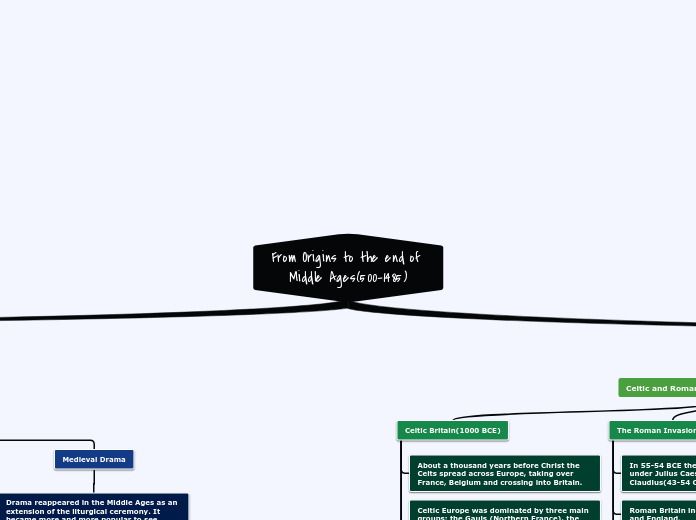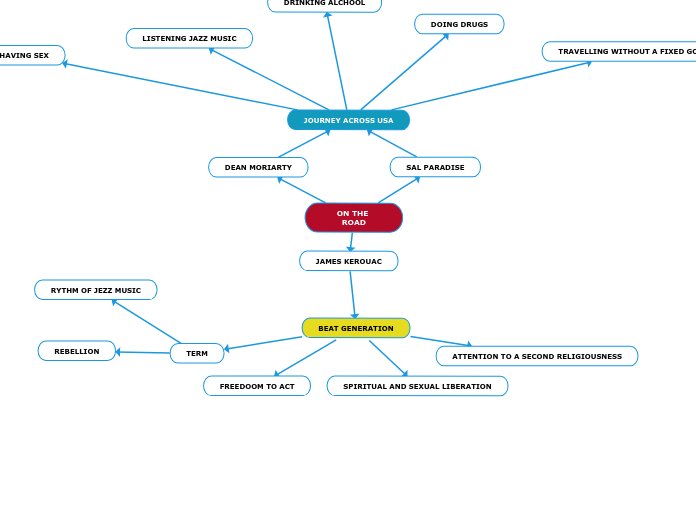From Origins to the end of Middle Ages(500-1485)
English' literature
Middle Ages Literature
Sottoargomento
Medieval Drama
Drama reappeared in the Middle Ages as an extension of the liturgical ceremony. It became more and more popular to see certain kee episodes of the Scriptures being performed as "dramatic representations" during the mass.
Between the 14th and the 15th centuries miracle plays underwent some transformations, their religious overall aspect became weaker, characters became an allegorical representation of vices and virtues: a new dramatic genre emerge: the morality play.
The most effective example of this morality play is Everyman.
Between the 13th and the 14th centuries they became standardised. They also started to be written in English and to be organised in cycles, wich were led to specific places, subjects and themes. These plays where called miracle plays, played on decorated cart called pageants.
Ballads
Lord Randal is one of the most famous example of ballads, it was transmicted trought genererations as a folk ballad.
The main stylistic features of ballads are: use of simple and common language, use of the lines that have a question-answer structure, the presence of refrains.
The most common themes were local events, the actions of famous heroes, tragic or supernatural events
The Ballad was a narrative poem, originally meant to ber accompanied by music. It was anonymous and transmitted orally.
Romances
Medieval Romances can be divided into three main cycles according to their subject: the Mattter of Rome, the Matter of France and the Matter of Britain
It's two main theme are courtly love and chivalry, it's characterised by adventures, supernatural encounters, exotic settings and magic objects.
It's a poetic composition, revolves around the actions of valiant knights
Romances were the most popular poetic genre of the Middle Ages.The Romance was born in France and spread all over Europe thanks to travelling ministrels. After the Norman invasion were imported in England becoming a very popular genre.
Anglo-Saxon Literature
Poetry
Beowulf
Main themes and style the most important themes are:
Christian values: the poems contains many references to christian values, these elements does not belong to the original story but are a later addition made by an anonymous author, probably christian.
The struggle between good and evil: Beowulf is the quintessence of the good man confronted with the need to defeat evil.
The supernatural: the poem is full of supernatural creature, an evil presence that the hero needs to expel. They represent the test and the obstacles the hero need to improve himself.
The meaning of heroism and the qualities of a good leader: the poem explores Beowulf's growth as a man, a leader and a warrior.
A perfect Hero
His death, when he encounters his implacable fate, represents the climax of his heroic life.
Beowulf is also a reflective character, on the final part he reflects on his responsabilities as a king and sacrifice his life for his country.
He is not a flat character, his heroism evolve throughout the poem going from the youthful heroism towards a more mature form of heroism mixed with wisdom.
Beowulf is represented as the perfect hero, he embodies all the virtues and the qualities of the perfect warrior: loyalty, bravery, strenght and wisdom.
Plot
The poem ends with the description of Beowulf's funeral: his body is burnt in a funeral pyre and his rest are buried with the dragon's treasure in a place overlooking the sea.
In the second part of the poem Beowulf is presented as a wise and old king. but despite the old age is asked to fight another dragon. He manages to defeate the monster but during the fight he is mortally wounded.
In the first part he travels to the land of the Danes to free it from Grendel, a terrible dragon.
It take place in an area known as Scandinavia and revolvs around the actions of the Scandinavian prince Beowulf
A germanic legend
Beowulf is contained in a manuscript wrote down by two scribes around the year 1000 CE.
An other theory is that it developed out of a Germanic oral tradition through the activity of many storytellers contributing to his final form.
It was composed between 700 and 1000 CE. Today scholars tend to believe that Beowulf it's a single-author poem composed by a cultured man who was probably christian and spoke Old English in an Anglo-Saxon court.
Theory
Translations and Religious Drama
Drama Perfomances
Liturgical representations were perfomances related to Christ's death and resurrection and were enacted in churches.
Drama perfomances came back to life in this period thanks to liturgical representations.
Prose
Literary prose in Old English began thanks to king Alfred, who translated Bede's historical treatise and Boethius's philosophical essay.
Epic poetry and Elegy were the two main literary genres. Anglo-Saxon Literature is centred around religious subject
The most important traits are: use of fixed stress-pattern, use of allitterations, use of kennings.
Elegy
"The Seafarer" is the most famous elegies amon Anglo-Saxon, it's a moving reflection on the hard conditions of life of an explorer of the sea.
It is chacacterised by a pervading sense of melancholy, the adoptation of a meditative tone and the focus on themes of loss and griefs.
Epic Poetry
Beowulf has a strong adventurous tone and it is full of encounters with supernatural creatures and great battle scenes. It is also pervaded by a strong sense of sadness, tipical of Anglo-Saxon poetry.
The poem revolves around the actions and life of Beowulf, a Scandinavian Prince chacacterised by his bravery, heroism and altruism
Beowulf is the most important poetic work of the Anglo-Saxon Age, it was composed between the 600 and the 800 CE.
The main themes of Anglo-Saxon poetry are bravery, heroism and supernatural.
Historical and Social background
Norman England
The War of the Roses(1455-1485)
Henry VII united the two families through a marriage, bringing a period of strenght and growth to England, and marking the end of the Medieval Period.
The conflict came to an end with the battle of Bosworth Field in 1485 where Henry of Lancaster defeated the last of the York kings, Richard III.
This dinastic struggle went on for 30 years and was called War of the Roses because of the two Houses' symbols.
England was torn by a quarrel between two branches of the Plantagenet Royal Family: The House of York and the House of Lancaster.
The Black Death(1348)
Nearly ahlf of the population died: this was the worst plague the nation had ever suffered
It has been a plague which swept across Europe and reached England in 1348.
The Hundred Years' War(1337-1453)
Joan of Arc led the France to victory and over the following years the French regained their territories. By 1453 the only English possesion in France was the Port of Calais.
Under Edward III there were important victories at Crecy and Poitiers and with Henry V at Agincourt.
It's aim was to regain lost territories in France and to put a doubtful claim to the French Throne
The Hundred Years' War began in 1337 but did not go on continously, there were several intervals.
King Jhon(1199-1216)
King Jones signs the Magna Carta(1215)
It established freedom under the rule of law for all men and declared that also the king was subject to the law of the land.
In 1215 they forced him to sign the Magna Carta at Runnymede
The barons rebelled against their king because of Jhon's oppressive reign.
After Richard's death he became king. He continued fighting unsuccessful wars in France until he lost all French's possessions
Henry II and his son Richard(1154-1199)
During his absence his brother Jhon reigned in his stead, he was an unopopolar figure.
Richard the Lioneheart spent only 6 months of his reign in England because he spent all the time on crusade in Palestine and fighting in France to regain the territories he had lost during his absence
First king in the French Plantagenet line. Strong king, able soldier: he dominated most of France
William the Conqueror(1066-1087)
In 1085 William commisioned a detailed survey of the land and wealth in English so he could calculate how much money he could erase with taxes: the Domesday Book.
The Normans also brought their language: Norman French which, with Latin, became the languages of Church and Government.
The defeated Anglo-Saxons were reduced as serfs and lost their property and rights.
The Normans introduced the feudal system and built castels to defend their conquest.
Anglo-Saxon Britain(660-1066 CE)
The last invasion(900-1066 CE)
Harold was killed and the Anglo-Saxon reign came to an end.
William the Conqueror, Duke of Normandy, with an impressive army defeated the Anglo-Saxons at the Battle of Hastings on 14 October 1066.
He was forced to move the army to the south coast to front a Norman invasion
Harold, the last Anglo-Saxon king, defeated the vikings at the battle of Stamford Bridge in 1066.
King Alfred,Edward and Edgar (871-975 CE)
King Edgard(959-975)issued laws recognising the multy-ethnic character of England at the time.
(Alfred's son) Edward the Elder(900-924) reconquered the Danelaw-
The Danes maintained the possession of north-eastern England(the Danelaw) but left Wessex undisturbed
As the vikings prepared a large army to conquer the whole island, King Alfred the Great(871-900) united the Anglo-Saxon people against the Danes
Viking Raids(793 CE)
Over the next few decades many monasteries in the North were destroyed
In 793 Vikings raiders attacked the Monaster of Lindisfarne on the coast of Northumbria.
Raids by seaborne Vikings(scandinavian) warriors began at the end of the 8th century
The Anglo Saxon Heptarchy(660-800 CE)
Anglo-Saxon was divided innto 7 kingdoms
Sussex
Wessex
Essex
Mercia
East Anglia
Northumbria
Kent
Over the centuries the Germanic fought to conquer territories
Celtic and Roman Britain (1000-410 CE)
End of the Roman Occupation and Beginning of Anglo-Saxon England(410 CE)
They spoke dialects of a language we now call "Old English". We still find traces of its vocabulary in modern english, and it is generally mono-syllabic and refers to common fields like animals and the body.
New invader arrived from across the North Sea: these were Germanic tribes of Anglos, Saxon and Jutes.
The last Roman soldiers left Britain in 410 CE to fight on the continent
For nearly 400 years southern Britain was part of the Romn World.
The Roman Invasion(43 CE)
The Romans brought their civilisation to Britain: their language(latin), their religion(Christianity) and building towns, roads stone villas and aqueducts.
To defend the province of "Britannia" the Romans built a wall under Emperor Hadrian: the "Hadrian's Wall which runs from coast to coast marking the northernmost frontier of the Roman Empire.
Roman Britain included present-day Wales and England.
In 55-54 BCE the Romans raided the island under Julius Caeser and under Emperor Claudius(43-54 CE) they conquered it.
Celtic Britain(1000 BCE)
Their religion was Druidism and its most importand divinity was the sun; Stonehenge may have been connected whit their worship of the sun.
They spoke a common language which is much older than English.
Celtic Europe was dominated by three main groups: the Gauls (Northern France), the Britons (Wales, Cornwall) and the Gaels (Ireland, Scotland)
About a thousand years before Christ the Celts spread across Europe, taking over France, Belgium and crossing into Britain.









